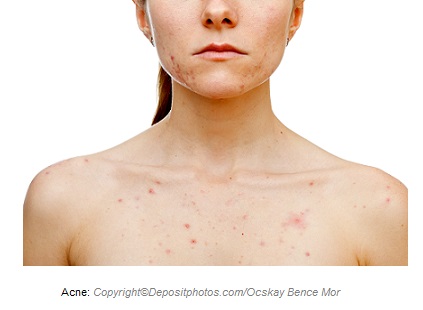Acne is a common skin condition characterized by pimples on the face,  back, neck, chest, and shoulders. It is an inflammatory condition of the sebaceous glands of the skin that causes oily skin, inflammation, whiteheads, and blackheads. Acne may sometimes be referred to as “acne vulgaris” and “zits”.
back, neck, chest, and shoulders. It is an inflammatory condition of the sebaceous glands of the skin that causes oily skin, inflammation, whiteheads, and blackheads. Acne may sometimes be referred to as “acne vulgaris” and “zits”.
Acne occurs more commonly during adolescence among males, and usually continues into adulthood. However, the possibility to develop acne decreases by age. Typical onset of acne is at puberty due to an increase in testosterone level.
Potential contributing factors:
- Genetics.
- Hormonal changes.
- Food allergies.
- Nutritional deficiencies, especially zinc, vitamins A, B6, B5 and B3.
- Poor digestion.
- Medications: anabolic steroids, phenytoin, lithium, corticosteroids, DHEA, isoniazid, disulfiram, and IGF- I.
- Environmental exposures: coal tar derivatives, halogenated hydrocarbons, machine oils, and dioxin.
- Emotional stress.
- Infection with Propionibacterium acnes (P. acnes).
- Yeast overgrowth.
- Oil-based cosmetics.
Nutritional Supports:
Restricted Foods:
- Saturated fats.
- Trans-fats containing foods: chips, cakes, pastries, doughnuts, muffins and cookies.
- Processed foods.
- Fried foods.
- Sugars and sweets. They worsen acne.
- Foods high in solanine: potatoes, tomatoes, eggplants, and peppers. Solanine is a poisonous plant alkaloid produced by the plants from nightshade family as a natural defense mechanism against external microorganisms. Solanine exacerbates inflammation.
- Foods high in Omega-6: soy, sunflower oil, safflower oil, corn oil, borage oil, sesame oil, and evening primrose oil. Omega-6, particularly Alpha-Linoleic Acid, is a pro-inflammatory.
- Inflammatory foods: red meats, eggs, and dairy products.
- Alcohol.
- Coffee.
- Allergenic foods.
- Sodas and aspartame-containing beverages.
- Food additives and preservatives.
- Vegetable shortenings.
- Chicken skins and wings.
Recommended Foods:
- Plenty of water: at least 2 liters a day.
- Whole grains.
- Legumes.
- Cold water fish: salmon, herring, sardines, and mackerel.
- Flaxseeds.
- Chia seeds.
- Hemp seeds.
- Fresh fruits and vegetables, except allergenic and solanine-containing ones.
- Fruits high in flavonoids: berries, and red grapes.
- Fruits and vegetables high in carotenoids: dark green and orange colored vegetables.
- Ginger.
- Pineapple.
- Alkaline diet.
- Spices high in antioxidants: sumac, turmeric, and cinnamon.
- Green tea.
- Chamomile tea.
Recommended Supplements:
- Vitamin B3: 50 – 100 mg a day. It may cause hot flushes.
- Zinc: 50 – 100 mg a day.
- Vitamin A: 5000 – 10000 IU a day.
- Chasteberry (Vitex) Extract: 160 – 320 mg a day. Vitex may reduce acne formation by balancing hormones and providing different phytonutrients including flavonoids and terpenoids.
- French Maritime Pine Bark Extract: 200 – 300 mg a day. It is a powerful antioxidant that reduces inflammation and improves blood circulation.
- Grape Seed Extract: 100 -200 mg a day.
- Omega – 3 Fatty Acids: 1 – 3 grams a day.
- Chromium Picolinate: 500 – 1000 mcg a day. It helps with adjusting blood sugar.
- Curcumin: 1000 – 1500 mg. It has anti-inflammatory and liver detoxifying properties.
- Digestive Enzymes: A full spectrum product.
- Probiotics: take a product that provides 5 to 10 billion active organisms per serving.
- Milk Thistle (with 70 – 85% silymarin): 400 – 500 mg a day. It supports liver detoxification.
- Saw Palmetto: 160 – 320 mg a day. It reduces acne formation by decreasing the production of DHT (dihydrotestosterone).
- Vitamin B5: 1000 – 2000 mg a day.
- Guggul Extract (2.5% guggulsterones):750 – 1500 mg a day.
- Multivitamin – Multiminerals: A high – potency product.
Topical Implications:
- Tea Tree Oil (a dilution of 5 – 10%): apply twice a day onto pimples.
- Azelaic Acid Cream 20%: apply the cream twice a day.
Miscellaneous Suggestions:
- Liver detoxification.
- Colon cleansing.

